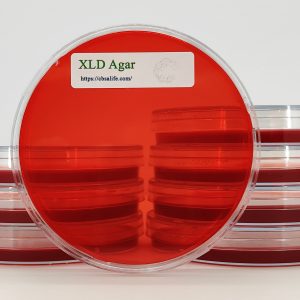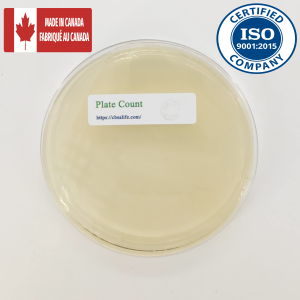Listeria Selective Agar is used for selective isolation and detection ofListeria monocytogenesfrom food and environmental samples.
INTENDED USE
Listeria-selective agar is for isolating and differentiating Listeria monocytogenes.
SUMMARY AND EXPLANATION
First described in 1926 by Murray, Webb and Swann, Listeria monocytogenes is a widespread problem in public health and the food industries. This organism can cause human illness and death, particularly in immunocompromised individuals and pregnant women. The first reported foodborne outbreak of listeriosis was in 1985. Since then, microbiological and epidemiological evidence from both sporadic and epidemic cases of listeriosis has shown that the principal route of transmission is via the consumption of foodstuffs contaminated with Listeria monocytogenes.
Implicated vehicles of transmission include turkey frankfurters, coleslaw, pasteurized milk, Mexican-style cheese, paté and pickled pork tongue. The organism has been isolated from commercial dairy and other food processing plants and is ubiquitous in nature, being present in a wide range of unprocessed foods and in soil, sewage, silage and river water.
Listeria spp. grow over a pH range of 4.4-9.6 and survive in food products with pH levels outside these parameters. Listeria spp. are microaerophilic, gram-positive, asporogenous, non-encapsulated, non-branching, regular, short, motile rods. Motility is most pronounced at 20°C.
The most common contaminating bacteria found in food sources potentially containing Listeria are streptococci, especially the enterococci, micrococci and Bacillus species, Escherichia coli, Pseudomonas aeruginosa and Proteus vulgaris.
Identification of Listeria is based on successful isolation of the organism, biochemical characterization and serological confirmation. Listeria-selective agar is prepared according to the formulation of Curtis et al. who originally described the medium and its use in the selective isolation of Listeria from mixed cultures.
PRINCIPLE
Peptones and beef heart digest provide nitrogen, carbon, amino acids and vitamins. Agar is the solidifying agent. Sodium chloride maintains the osmotic balance.
Ferric ammonium citrate aids in the differentiation of Listeria spp. Since all Listeria spp. hydrolyze esculin, the addition of ferric ions to the medium will detect the reaction. A blackening of the colony and surrounding medium in cultures containing esculin-hydrolyzing bacteria results from the formation of 6,7-dihydroxycoumarin which reacts with the ferric ions.
Selectivity is provided by the presence of lithium chloride in the formula. The high salt tolerance of Listeria is used as a means to markedly inhibit growth of enterococci.
Selectivity is increased by adding various antimicrobial agents to the base. Incorporating these agents into Listeria-selective agar will completely inhibit gram-negative organisms and most gram-positive organisms after 24 hours of incubation.
Listeria-selective agar is recommended for isolating and identifying Listeria monocytogenes from processed meat and poultry products.
| Container | 60mm Petri Dish, 100mm Petri Dish |
|---|---|
| Package | 1, 5, 10, 20 |
Only logged in customers who have purchased this product may leave a review.






Reviews
There are no reviews yet.